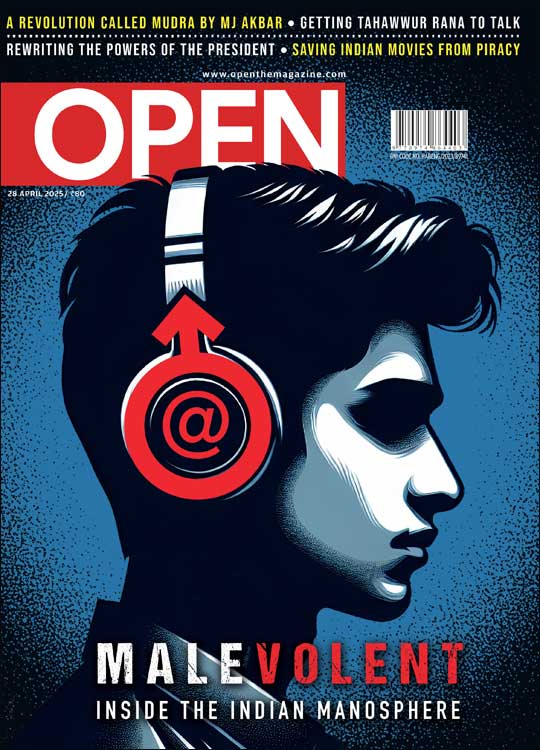A Change of Scene
With films drawn from life and literature, the music label Saregama begins the newest wave
 Divya Unny
Divya Unny
 Divya Unny
Divya Unny
 |
03 Aug, 2017
|
03 Aug, 2017
/wp-content/uploads/2017/08/Changeofscene1.jpg)
WHEN A SALMAN Khan film like Tubelight tanks in India, you know that something is changing. When a film about female desire like Lipstick Under My Burkha breaks records (earning more than double its projected figure), you know that change is afoot. This is not to say that the era of mass- entertainment blockbusters is done. There will always be takers for the Rs 100-crore money spinner. But, slowly and surely, the window for films that are closer to our reality seems to be widening, and with good reason. In the 1970s, it was called the ‘parallel cinema movement’; in the 1980s it became ‘art house’; in the 1990s it emerged as the ‘new wave’; and in the last decade, we simply called it ‘films with meaning’. Simple, bold and relatable stories have come to define the new cinema.
In a move that might alter the way we approach and choose what films to watch in India, Saregama (part of the RP-Sanjiv Goenka Group, which publishes Open), one of India’s biggest music labels, has come up with Yoodlee Films. This isn’t merely a studio that has chosen to make movies, but is an attempt to change the culture of cinema in Bollywood. Starting this September, Yoodlee promises us 100 offbeat films over a span of five years.
These stories are drawn from life and literature. From a 65-year-old woman fighting the system to avenge her granddaughter’s assault, to an eight-year-old Kashmiri boy looking for answers about his father’s disappearance, to a husband and wife dealing with the horror that their relationship might be incestuous, these are films that don’t fit into neat boxes. Vikram Mehra, managing director, Saregama, says, “Two years back when we spoke to film lovers, we realised that Bollywood meant escapism for many of the crowd above the age of 40. But then the younger crowd was in search of something better, grittier. They were not afraid to be told the truth about the society that we live in. In a world where cinema has shrunk to such an extent that we have access to films from across the world at the click of a mouse through torrents, or Netflix or Amazon, it’s high time we started telling stories that are at par with those from across the globe. So we signed up filmmakers who were willing to take the plunge and were passionate enough to tell stories that were more universal in nature.”
To create these universal stories, the filmmakers have chosen strong content over star casts, foreign locales or sexy item numbers. The filmmakers of these multi-lingual films (all less than 120 minutes each) were certain they did not want to merely toe the line of what ‘sells’.
Mehra says, “We are sharing 30 per cent profits with the primary cast and crew of the film. Also the budgets don’t really matter because each film that we are putting out looks as good as any regular feature film. Costs go up when you have a popular cast and we weren’t interested in that. We cast actors who can tell a compelling story in a way that it needs to be told. We don’t go behind stars,” he says.
Spanning different languages, from Hindi to Tamil to Urdu, these stories come from various corners of the country, and reflect different cultures and the conflicts within. Many of these are the kind of films that attract accolades at film festivals, but may not find a release back home simply because they are not what mass audiences are used to watching. “We knew that our films are going to be true to the milieu only if they are going to be done in a language that is true to the people in the film. For example, there is a film that is themed around the bullying that happens in the premium boarding schools of our country. These are kids from elite families who may swear in Hindi but they speak in English. So the primary language of the film is English. If independent cinema has always struggled in the hands of filmmakers trying so hard to find a release, then we are trying to change that,” says Mehra.
Here is an exclusive peek at the first five films that will hit the big screen.
AJJI
104 minutes (Hindi)
Director: Devashish Makhija
Dark and gritty, Ajji is about a 65-year-old arthritis-ridden grandmother avenging the sexual assault of her nine-year-old granddaughter by a local political goon. The film raises many questions about the abuse of children in the country and the silence around it.
In the 1970s, it was called the parallel cinema movement; in the 1980s it became art house; in the 1990s, the new wave; and in the last decade, we simply called it ‘films with meaning’
For director Devashish Makhija, this story has lingered in his conscience for over five years. “Ever since the Nirbhaya incident, I have wanted to tell a story of how women are treated in India. Now that this debate has entered the mainstream, I think Ajji is coming at the right time. There are too many stories of women suffering at the hands of the patriarchy, and this one about a much older lady standing against the system will hopefully force people to think,” says Makhija.
Shot over a span of 21 days in some of the dark alleys of Mumbai, the film highlights the battle of an elderly woman against the system. “There are many people she is fighting here; her own son and daughter-in-law, the goons, the police. As a director, I had complete freedom to tell the story the way I wanted to and that was a big relief,” says Makhija.
Ajji has already been invited for festivals in Busan, London and Estonia. It is also set for an international release. “We as audiences are used to being very comfortable with our cinema, because that’s what we are served. The minute a film jolts you, it’s questioned and banned and protested against. That’s where you win as a storyteller, and hopefully Ajji will have that effect,” he adds.
NOBLEMEN
104 minutes (English)
Director: Vandana Kataria
This is an underdog story about a 15-year-old who fights to escape bullies in his boarding school. Told through the eyes of a group of teenagers, the film speaks the universal language of adolescent struggles. For director Vandana Kataria, who has been the production designer on films like Oye Lucky! Lucky Oye! and Shanghai, this was not just semi-autobiographical, but also a story she was waiting to tell.
“I studied in a boarding school and the story came from certain experiences that I grew up with. We were supposed to take a leaf out of literature in our films. And The Merchant of Venice, which is also a play within the film, was the perfect parallel to the main plot. We have used monologues from the text as is to depict the conflicts and internal journey of the protagonists,” says Kataria, who had just six months to write the film, once on board. She confesses it was a tight-rope walk. “They are looking for filmmakers with a voice of their own. This was by no means an easy film to make in terms of timelines, but in a situation like that, you make the most of it. Eventually I ended up learning so much more about the process, I have a film out there and I am inspired to make my next,” she says. She calls it a dark and unnerving film. In India we don’t see films that address issues of teenagers and their lives. There is a lot of struggle within this age group that we do not acknowledge. The movie has been made in English as that is the first language of the children shown in it. But the message is sure to go beyond the language.
BRIJ MOHAN AMAR RAHE
100 minutes (Hindi)
Director: Nikhil Bhat
Brij Mohan makes its point through dark humour. Set in Delhi, around the life of a hosiery shop owner, this is a satire on the multiple lives we all lead. “This could be the story of anyone living in an urban space. In cities we develop a kind of selfishness within our very busy lives. It’s all about my work, my growth, my luxuries, my comfort, my family. So the film is about this one character embroiled in his mundane life who is a victim of his immediate environment. He makes one mistake and is asked to pay for it,” says Bhat whose debut film Saluun (2009) premiered at the Cairo International Film Festival. Bhat believes we hardly tell stories of grey characters, and as a culture we try to box people into black or white. Through Brij Mohan, he wanted to break that stereotype. “I think it’s high time we told stories about people we see around us. There are many mysterious ones, we just need to open up to them. We shot across 42 locations in Delhi in 21 days, but not once did we feel like it wasn’t worth it, despite the constraints,” says Bhat.
“In a world where cinema has shrunk to such an extent that we have access to films from across the world at the click of a mouse, it is high time we started telling stories that are at par with those from across the globe” – Vikram Mehra, managing director, Saregama
ABHI & ANU
121 minutes (Malayalam/Tamil)
Director: BR Vijayalaxmi
The senior most of the first lot of directors signed on to make these films, Vijayalaxmi comes from the old-school South Indian cinema space. She is often referred to as India’s first female cinematographer and began her film journey with K Bhagyaraj’s Chinna Veedu in 1985. Interestingly, she returns with this film after a 16-year sabbatical to tell the story of a married couple who realise they are born to the same parents.
“It’s based on the story of a real couple in Brazil who didn’t know they are actually brother and sister. Of course, the nature of the story was such that not a single actor or actress from Tamil Nadu was open to doing it. I had to delve into the minds of someone who is in a situation like this, and create empathy for them. We are not used to seeing the other side of relationships in India, and that was a real challenge for me to portray,” says Vijayalaxmi who faced rejections and challenges during the filming. “I wanted to use images from this book Hope For the Flowers by New York-based author Trina Paulus for the film, but she simply refused after hearing the story of the film. She breeds butterflies herself and told me she doesn’t encourage cross breeding within them, so it’s out of the question to associate with a film that talks about it. So it was a subject that almost no one is comfortable with.” But Vijayalaxmi was not to be deterred. “When I quit films it always hit me in the gut that I haven’t been able to go back on the field and shoot. Today I come back with a story that speaks the language of my teenage son perhaps, and that’s a motivating factor for me,” she says.
ASCHARYA CHAKIT
95 minutes (Hindi)
Director: Samit Kakkad
Reeling from the success of his Marathi film Half-Ticket, Samit Kakkad takes inspiration from Saadat Hasan Manto for his latest. The film is about the lives of a Bollywood superstar, his driver, a prostitute, a pimp, and underlines the underbelly of glamour. His characters come from the stories of Manto, but live and breathe in today’s world. “Manto documented lives of people from the 20s and 30s. He spoke about sex workers and the like, who were often ignored in modern literature. There was a lot of truth in his stories, which many people refused to realise. Ascharya Chakit (originally Ascharya Fuck It) exposes many truths within the underbelly of the film world,” says Kakkad. According to him this is a film that people will buy a ticket for only if it’s marketed well. “You understand the kind of cinema you want to be part of, but your audience is unaware until they come and see your work. The initial plan for all of these films was a festival run and an online release, but now that it’s on the big screen why not make the most of it? We are used to a certain kind of cinema ruling our theatres and that’s okay. But it’s our job as storytellers to put out all kind of films so people can make that choice,” he says. The film opens with a quote by Manto: ‘If you find my stories dirty, the society you are living in is dirty. With my stories, I only expose the truth.’

/wp-content/uploads/2025/04/Cover-Manosphere.jpg)













More Columns
The Best of IPL 2025 Aditya Iyer
India cancels visas to Pak nationals, asks forces to stay alert Ullekh NP
First step post Pahalgam, India scraps Indus Treaty Siddharth Singh